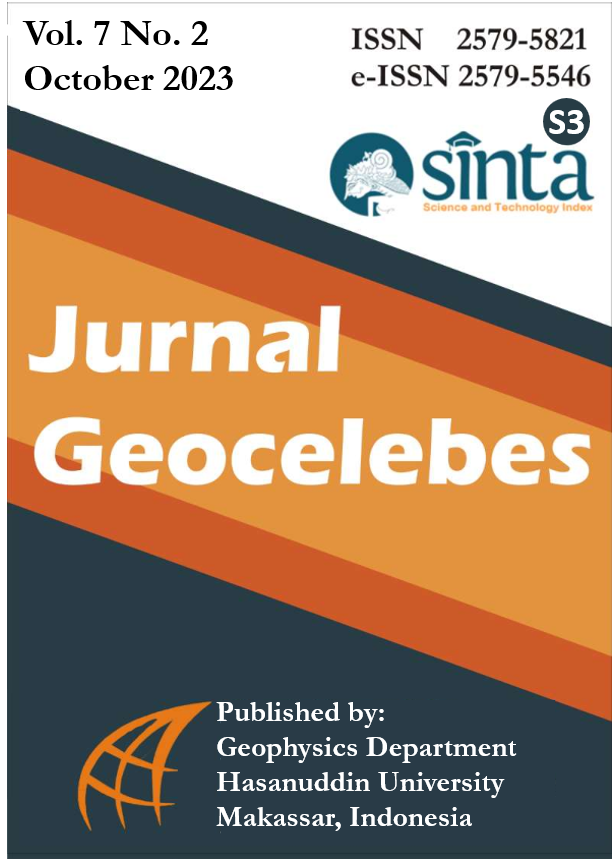Relocation of the Hypocenter of an Earthquake with the Double Difference Method in the Regional Study Area of Yogyakarta
Relokasi Hiposenter Gempabumi menggunakan Metode Double Difference Wilayah Kajian Daerah Istimewa Yogyakarta
DOI:
https://doi.org/10.20956/geocelebes.v7i2.22223Keywords:
double difference, fault, hypoDD, residual histogram, subductionAbstract
The relocation of the earthquake hypocentre is necessary in order to determine the position of the earthquake centre with higher accuracy. An accurate hypocentre position is important for earthquake-prone areas mapping, seismicity analysis, and fault zone identification. The double difference algorithm technique using the hypoDD program can be used for hypocentre relocation. This article reports the earthquake relocation of 23 earthquakes in the Yogyakarta region recorded at four observation stations. The result shows that the hypocentre shift spreads randomly with a shift distance of less than 20 km, with the most shifting direction of the epicentre to the northeast. The Earthquake’s hypocentre after relocation in the land area is estimated to be triggered by a fault under the Gamping Wungkal Formation, while the earthquake around Mount Merapi is estimated to be triggered by volcanic activity. The Relocation result in the sea area show that the hypocentre leads to the subduction line.Downloads
References
Diaz, N., Suarbawa, K. N., & Mursitantyo, A. (2018). Relokasi Gempabumi di Pulau Bali Bagian Utara Tahun 2015- 2017 dengan menggunakan Metode Double Difference (DD). Buletin Fisika, 19(2), 64–72. https://ojs.unud.ac.id/index.php/buletinfisika/article/view/43518
Fathani, T. F., & Wilopo, W. (2017). Seismic microzonation studies considering local site effects for yogyakarta city, indonesia. International Journal of GEOMATE, 12(32), 152–160. http://dx.doi.org/10.21660/2017.32.63655
Harlianti, U., Nugraha, A. D., & Indrastuti, N. (2017). Relocation of volcano-tectonic earthquake hypocenter at Mt. Sinabung using double difference method. AIP Conference Proceedings, 1857(070004), 1-6. https://doi.org/10.1063/1.4987092
Kusmita, T., Pribadi, I., MZ, N., & Rohadi, S. (2020). Studi Awal Seismotektonik di Wilayah Jawa Barat Berdasarkan Relokasi Hiposenter Metode Double Difference. Jurnal Geosaintek, 6(1), 43–50. http://dx.doi.org/10.12962/j25023659.v6i1.6697
Nurbaiti, Y., Ibrahim, E., Hasanah, M. U., & Wijatmoko, B. (2019). Application of double-difference method for relocating aftershocks hypocenters in Opak Fault Zone. IOP Conference Series: Earth and Environmental Science, 311(012028) 1-6. https://iopscience.iop.org/article/10.1088/1755-1315/311/1/012028
Puspita C., Nugraha, A. D., & Puspito, N. T. (2015). Earthquake hypocenter relocation using double difference method in East Java and surrounding areas. AIP Conference Proceedings, 1658(030021), 1–3. https://doi.org/10.1063/1.4915029
Qodri, M. F., & Sopamena. R. A. (2022). Mineralogical and geochemical characterization of the Wonosari formation limestone at Gunungkidul Indonesia as preliminary investigation of Portland cement raw material. IOP Conference Series: Earth and Environmental Science, 1151(012026), 1–9. https://iopscience.iop.org/article/10.1088/1755-1315/1151/1/012026
Ramdhan, M., Kristyawan, S., & Sembiring, A. S. (2020). Seismisitas di Wilayah Jawa Tengah dan Sekitarnya Berdasarkan Hasil Relokasi Hiposenter dari Empat Jaringan Seismik Menggunakan Model Kecepatan 3-D. Eksplorium, 41(1), 61–72. http://dx.doi.org/10.17146/eksplorium.2020.41.1.5828
Sabtaji, A., & Nugraha, A. D. (2015). 1-D seismic velocity model and hypocenter relocation using double difference method around West Papua region. AIP Conference Proceedings, 1658(030005) 1-8. https://doi.org/10.1063/1.4915013
Setiadi, T. A. P., Rohadi, S., & Heryandoko, N. (2017). Earthquake relocation in Mollucas Sea using teleseismic double difference method for tectonic setting analysis. AIP Conference Proceedings, 1857(020007). 1–6. https://doi.org/10.1063/1.4987049
Setiadi, T. A. P., & Rohadi, S. (2018). Relokasi Gempa Bumi Teleseismik Double-Difference di Wilayah Bali - Nusa Tenggara dengan Model Kecepatan 3D. Jurnal Lingkungan dan Bencana Geologi, 9(1), 45–52. http://dx.doi.org/10.34126/jlbg.v9i1.149
Supendi, P., Nugraha, A. D., Widiyantoro, S., Abdullah, C. I., Puspito, N. T., Palgunadi, K. H., & Wiyono, S. H. (2019). Hypocenter relocation of the aftershocks of the Mw 7.5 Palu earthquake. Geoscience Letters, 6(1), 1–11. https://doi.org/10.1186/s40562-019-0148-9
Surono. (2009). Litostratigrafi Pegunungan Selatan Bagian Timur Daerah Istimewa Yogyakarta dan Jawa Tengah. Geo-Sciences, 19(3), 209–221. https://doi.org/10.33332/jgsm.geologi.v19i3.206
Syafriani., Raharjo, F. D., Ahadi, S., & Ramdhan, M. (2023). Study of Seismicity Based on the Results of Hypocenter Relocation Using Double Difference (HypoDD) Method in West Sumatera and Its Surrounding. Jurnal Penelitian Pendidikan IPA, 9(7), 5150–5156. https://doi.org/10.29303/jppipa.v9i7.3792
Utama, M. R. J., Nugraha, A. D., & Puspito, N. T. (2015). Seismicity studies at Moluccas area based on the result of hypocenter relocation using HypoDD. AIP Conference Proceedings, 1658(030022) 1-4. https://doi.org/10.1063/1.4915030
Waldhauser, F. (2001). hypoDD -- A Program to Compute Double-Difference Hypocentre Locations. Menlo Park, U.S Geol. Survey. https://doi.org/10.3133/ofr01113
Waldhauser, F. & Ellsworth, W. L. (2000). A double difference earthquake location algorithm: Method and application to the northern Hayward fault, California. Bulletin Seismological Society of America, 90(6), 1353–1368. https://doi.org/10.1785/0120000006
Wartono, R., Sukandarrumidi., & H. M. D. Rosidi (1977). Peta Geologi Lembar Yogyakarta. Pusat Penelitian dan Pengembangan Geologi.
Wibowo, N. B., dan Sembri, J. N. (2017). Analisis Seismisitas dan Energi Gempabumi di Kawasan Jalur Sesar Opak-Oyo Yogyakarta. Jurnal Sains Dasar, 6(2), 109–115. https://journal.uny.ac.id/index.php/jsd/article/view/15544
Yulianto, Y., Nugraha, A. D., & Wiyono, W. S. (2017). Hypocenters relocation using double-difference method around Molucca Collision Zone. AIP Conference Proceedings, 1857(020002), 1–4. https://doi.org/10.1063/1.4987044
Downloads
Published
How to Cite
Issue
Section
License
Authors who publish with this journal agree to the following terms:
- Authors retain copyright and grant the journal right of first publication with the work simultaneously licensed under a Creative Commons Attribution License that allows others to share the work with an acknowledgement of the work's authorship and initial publication in this journal.
- Authors are able to enter into separate, additional contractual arrangements for the non-exclusive distribution of the journal's published version of the work (e.g., post it to an institutional repository or publish it in a book), with an acknowledgement of its initial publication in this journal.
- Authors are permitted and encouraged to post their work online (e.g., in institutional repositories or on their website) prior to and during the submission process, as it can lead to productive exchanges, as well as earlier and greater citation of published work (See The Effect of Open Access).



